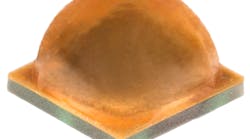The packaged LED product sector continues on a torrid pace in terms of new product announcements with both Seoul Semiconductor and Philips Lumileds adding mid-power products this week. Seoul has integrated high-power-like features in the Acrich MJT 2525 LED with a 22V forward voltage and new package that includes a primary optic. Lumileds, meanwhile, made its fourth mid-power announcement this month with the Luxeon 3020 LED designed to deliver maximum lumens per dollar.
Acrich MJT 2525 LED
The new Seoul LED is based on what the company refers to as multi-junction technology (MJT). Essentially the MJT LEDs integrate multiple emitters in one monolithic chip with the emitters connected in high-voltage configurations in the back-end of the manufacturing process with no requirement for bond wires. The 22V forward voltage of the new LED will simplify driver design and enable better system efficiency.
The Seoul high-voltage announcement follows a Lumileds announcement of a high-voltage mid-power architecture earlier in the month. The high-voltage approach has been widely used in high-power LEDs but is new to the mid-power segment beyond the combination of two or three emitters at levels of 10V and below.
Perhaps more significantly, the new Seoul design includes a package architecture more like that used in high-power LEDs. The included primary optic provides a broader 130° beam distribution than is typical in mid-power LEDs. Moreover, it should be useable with total internal reflection lenses. Seoul didn’t reveal the details of the package material, only saying that the design is capable of reliable operation at high currents.
Indeed, the new LED specs go well beyond the 0.5W upper limit that has traditionally defined the mid-power segment. Seoul said that the new LED delivers 95 lm and efficacy of 105 lm/W from a 40-mA input current at 25°C. That performance places the LED at the 0.9W level, although maximum drive current is 25% higher taking the device over 1W.
Seoul announced the LEDs across a range of 2600K to 3700K CCTs with a CRI of 80. The company expects the LEDs to find use in retrofit lamps, directional lamps and luminaires, and architectural-class indoor lighting products. As the model number implies, the LED measures 2.5 mm per side.
"The new 2525 Series has unparalleled lumen density in the mid-power class of LEDs, not only reducing the total system costs for designers but also enabling new possibilities in lighting design," said Jay Kim, the executive vice president of Seoul's lighting sales division. "The MJT 2525 series has higher cost efficiency than most mid-power packages and has already been adopted worldwide in a number of designs by key customers."
Lumileds Luxeon 3020
Lumileds’ latest product, meanwhile, falls at the other end of the mid-power spectrum with a focus on lowering SSL system cost in specific applications such as troffers and linear tubes where more LEDs that generate less flux output are typically utilized in closely-spaced configurations. The company said the Luxeon 3020 is the most affordable of the company's mid-power portfolio and that it delivers 1000 lm per dollar.
The new LED does also cross the legacy mid-power boundary because the cost effectiveness comes, in part, courtesy of the fact that the plastic-packaged LED can operate at a maximum of 240 mA and deliver 90 lm, well above 0.5W operation. The LEDs would be more typically driven in the 100- to 120-mA range.
Philips is offering the hot-targeting feature with the 3020 LED that it announced recently with the Luxeon 3030 2D family. The LED package and phosphor combination is designed to perform above the black-body curve at room temperature while moving to the center of designated bins at typical operating temperatures.







